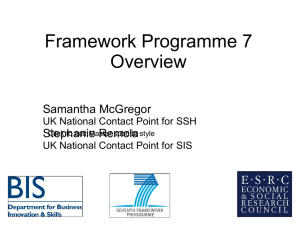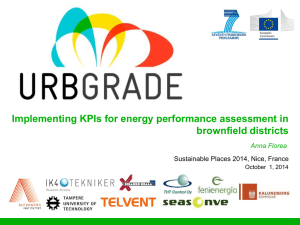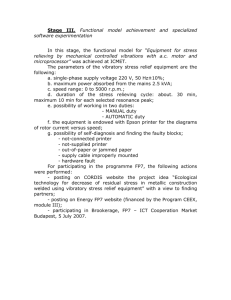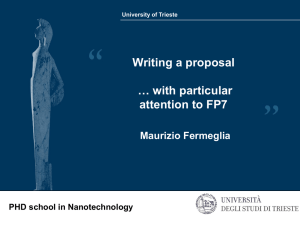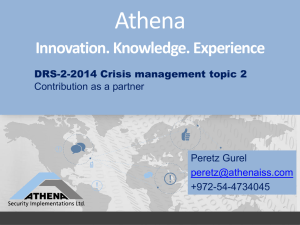Open Access Pilot Further details on this open access pilot in FP7 can...
advertisement
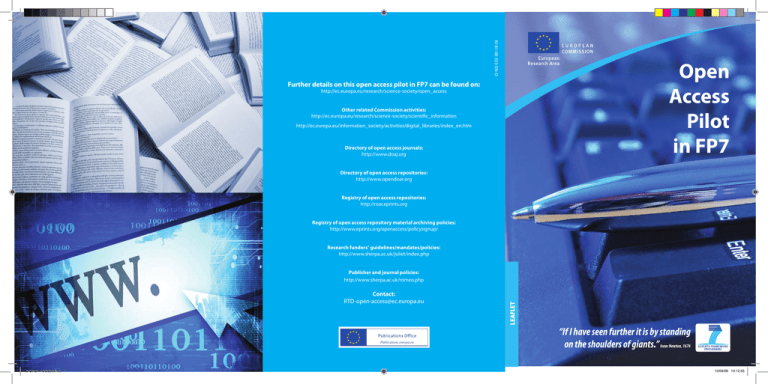
KI-81-08-333-EN-D Open Access Pilot in FP7 Further details on this open access pilot in FP7 can be found on: http://ec.europa.eu/research/science-society/open_access Other related Commission activities: http://ec.europa.eu/research/science-society/scientific_information http://ec.europa.eu/information_society/activities/digital_libraries/index_en.htm Directory of open access journals: http://www.doaj.org Directory of open access repositories: http://www.opendoar.org Registry of open access repositories: http://roar.eprints.org Registry of open access repository material archiving policies: http://www.eprints.org/openaccess/policysignup/ Research funders’ guidelines/mandates/policies: http://www.sherpa.ac.uk/juliet/index.php Contact: RTD-open-access@ec.europa.eu LEAFLET Publisher and journal policies: http://www.sherpa.ac.uk/romeo.php “If I have seen further it is by standing on the shoulders of giants.” Isaac Newton, 1676 2-OPEN ACCESS.indd 1 10/09/08 10:12:55 > Introduction > Different types of open access All research builds on former work, and depends on scientists’ possibilities to access and share scientific information. The advent of the internet and electronic publishing have resulted in unprecedented possibilities for the dissemination and exchange of information. ‘Open access’, defined as free access over the internet, aims to improve and promote the dissemination of knowledge, thereby improving the efficiency of scientific discovery and maximising return on investment in R&D by public research funding bodies. Open access to journal articles can be achieved in different ways. Two basic models are currently under experimentation: Open access publishing: the costs of publishing are covered by authors (in practice usually by the funding bodies supporting them) or other sources (often university libraries) instead of readers paying via subscriptions. This type of publishing is offered by open access journals and by “hybrid” journals (subscription-based journals offering authors the option to pay for their article to be available open access). It ensures that research articles are immediately available in open access mode as soon as they are published. Open access publishing is also referred to as “gold” open access. The European Commission is conducting a pilot initiative on open access to peer reviewed research articles in its Seventh Research Framework Programme (FP7). In this pilot, open access to articles resulting from research funded in areas participating in the pilot should be provided within a specified time period. This pilot will run until the end of FP7. Self-archiving: authors deposit the peer-reviewed manuscripts of their articles in repositories (also called open archives), to be available in open access mode, sometimes after an embargo period in order to allow publishers to recoup their investment. Self-archiving is also referred to as “green” open access. > Scope of open access pilot This FP7 open access pilot is based on “green” (self-archiving) open access. The Commission also provides the opportunity for “gold” open access in FP7 by reimbursing fully open access publishing costs during the duration of FP7 research projects. This initiative covers approximately 20% of the FP7 budget and applies to the following areas: • Energy; • Environment; • Health; • Information and Communication Technologies (Challenge 2: Cognitive Systems, Interaction, Robotics); • Research Infrastructures (e-Infrastructures); • Science in Society; • Socio-economic Sciences and Humanities. Grant agreements in these areas signed after the beginning of the open access pilot will contain a special clause requiring beneficiaries: 1. to deposit articles resulting from FP7 projects into an institutional or subjectbased repository; 2. to make their best efforts to ensure open access to these articles within six months (Energy, Environment, Health, Information and Communication Technologies, Research Infrastructures) or twelve months (Science in Society, Socio-economic Sciences and Humanities). 2-OPEN ACCESS.indd 2 > What to deposit? Either one of the documents described below should be deposited in an online repository: 1. Final published article: publisher’s final version of the paper, including all modifications from the peer review process, copyediting and stylistic edits, and formatting changes (usually a PDF document). It is expected that a publication in an open access journal will result in a final published article being deposited and available upon publication. Where articles are to be published in non-open access journals, beneficiaries (in practice usually researchers) should ascertain that selected journals’ copyright and licensing conditions allow for compliance with the open access pilot in FP7. This means that the selected journal must allow for deposit of the manuscript to a repository immediately upon publication, to be made open access within the specified embargo period. Where this is not the case, researchers should make their best efforts to negotiate copyright and licensing conditions that comply with the open access pilot in FP7.* During assessment of this pilot, the Commission will consider the need to review its provisions in view of further development in FP8. > Where to deposit? Researchers should deposit final articles or manuscripts into the institutional repository of the research institution with which they are affiliated. If this is not possible, they should identify an appropriate subject based/thematic repository. The Commission plans to provide a special repository for articles that can be stored neither in institutional nor in subject-based/thematic repositories. > When to deposit? Researchers should deposit their articles or manuscripts in a relevant repository immediately upon acceptance for publication, to be made open access within six or twelve month depending on the FP7 research area. > Finally... The European Commission encourages all grant recipients (not only those covered by the open access pilot) to consider the question of open access when submitting their articles for publication. This not only provides greater visibility to their work, thereby potentially leading to more citations and greater research impact, but also reduces the likelihood of wasting time and public resources on duplicative research. or 2. Final peer-reviewed manuscript: final manuscript of a peer-reviewed paper accepted for journal publication, including all modifications from the peer review process, but not yet formatted by the publisher (also referred to as “post-print” version). It is expected that a publication in a non-open access (usually subscription-based) journal will result in a final peer-reviewed manuscript being deposited within the specified embargo period. * Guidance on negotiating such conditions will be made available in the FP7 Guide to Intellectual Property Rules for FP7. 10/09/08 10:12:57 > Introduction > Different types of open access All research builds on former work, and depends on scientists’ possibilities to access and share scientific information. The advent of the internet and electronic publishing have resulted in unprecedented possibilities for the dissemination and exchange of information. ‘Open access’, defined as free access over the internet, aims to improve and promote the dissemination of knowledge, thereby improving the efficiency of scientific discovery and maximising return on investment in R&D by public research funding bodies. Open access to journal articles can be achieved in different ways. Two basic models are currently under experimentation: Open access publishing: the costs of publishing are covered by authors (in practice usually by the funding bodies supporting them) or other sources (often university libraries) instead of readers paying via subscriptions. This type of publishing is offered by open access journals and by “hybrid” journals (subscription-based journals offering authors the option to pay for their article to be available open access). It ensures that research articles are immediately available in open access mode as soon as they are published. Open access publishing is also referred to as “gold” open access. The European Commission is conducting a pilot initiative on open access to peer reviewed research articles in its Seventh Research Framework Programme (FP7). In this pilot, open access to articles resulting from research funded in areas participating in the pilot should be provided within a specified time period. This pilot will run until the end of FP7. Self-archiving: authors deposit the peer-reviewed manuscripts of their articles in repositories (also called open archives), to be available in open access mode, sometimes after an embargo period in order to allow publishers to recoup their investment. Self-archiving is also referred to as “green” open access. > Scope of open access pilot This FP7 open access pilot is based on “green” (self-archiving) open access. The Commission also provides the opportunity for “gold” open access in FP7 by reimbursing fully open access publishing costs during the duration of FP7 research projects. This initiative covers approximately 20% of the FP7 budget and applies to the following areas: • Energy; • Environment; • Health; • Information and Communication Technologies (Challenge 2: Cognitive Systems, Interaction, Robotics); • Research Infrastructures (e-Infrastructures); • Science in Society; • Socio-economic Sciences and Humanities. Grant agreements in these areas signed after the beginning of the open access pilot will contain a special clause requiring beneficiaries: 1. to deposit articles resulting from FP7 projects into an institutional or subjectbased repository; 2. to make their best efforts to ensure open access to these articles within six months (Energy, Environment, Health, Information and Communication Technologies, Research Infrastructures) or twelve months (Science in Society, Socio-economic Sciences and Humanities). 2-OPEN ACCESS.indd 2 > What to deposit? Either one of the documents described below should be deposited in an online repository: 1. Final published article: publisher’s final version of the paper, including all modifications from the peer review process, copyediting and stylistic edits, and formatting changes (usually a PDF document). It is expected that a publication in an open access journal will result in a final published article being deposited and available upon publication. Where articles are to be published in non-open access journals, beneficiaries (in practice usually researchers) should ascertain that selected journals’ copyright and licensing conditions allow for compliance with the open access pilot in FP7. This means that the selected journal must allow for deposit of the manuscript to a repository immediately upon publication, to be made open access within the specified embargo period. Where this is not the case, researchers should make their best efforts to negotiate copyright and licensing conditions that comply with the open access pilot in FP7.* During assessment of this pilot, the Commission will consider the need to review its provisions in view of further development in FP8. > Where to deposit? Researchers should deposit final articles or manuscripts into the institutional repository of the research institution with which they are affiliated. If this is not possible, they should identify an appropriate subject based/thematic repository. The Commission plans to provide a special repository for articles that can be stored neither in institutional nor in subject-based/thematic repositories. > When to deposit? Researchers should deposit their articles or manuscripts in a relevant repository immediately upon acceptance for publication, to be made open access within six or twelve month depending on the FP7 research area. > Finally... The European Commission encourages all grant recipients (not only those covered by the open access pilot) to consider the question of open access when submitting their articles for publication. This not only provides greater visibility to their work, thereby potentially leading to more citations and greater research impact, but also reduces the likelihood of wasting time and public resources on duplicative research. or 2. Final peer-reviewed manuscript: final manuscript of a peer-reviewed paper accepted for journal publication, including all modifications from the peer review process, but not yet formatted by the publisher (also referred to as “post-print” version). It is expected that a publication in a non-open access (usually subscription-based) journal will result in a final peer-reviewed manuscript being deposited within the specified embargo period. * Guidance on negotiating such conditions will be made available in the FP7 Guide to Intellectual Property Rules for FP7. 10/09/08 10:12:57 > Introduction > Different types of open access All research builds on former work, and depends on scientists’ possibilities to access and share scientific information. The advent of the internet and electronic publishing have resulted in unprecedented possibilities for the dissemination and exchange of information. ‘Open access’, defined as free access over the internet, aims to improve and promote the dissemination of knowledge, thereby improving the efficiency of scientific discovery and maximising return on investment in R&D by public research funding bodies. Open access to journal articles can be achieved in different ways. Two basic models are currently under experimentation: Open access publishing: the costs of publishing are covered by authors (in practice usually by the funding bodies supporting them) or other sources (often university libraries) instead of readers paying via subscriptions. This type of publishing is offered by open access journals and by “hybrid” journals (subscription-based journals offering authors the option to pay for their article to be available open access). It ensures that research articles are immediately available in open access mode as soon as they are published. Open access publishing is also referred to as “gold” open access. The European Commission is conducting a pilot initiative on open access to peer reviewed research articles in its Seventh Research Framework Programme (FP7). In this pilot, open access to articles resulting from research funded in areas participating in the pilot should be provided within a specified time period. This pilot will run until the end of FP7. Self-archiving: authors deposit the peer-reviewed manuscripts of their articles in repositories (also called open archives), to be available in open access mode, sometimes after an embargo period in order to allow publishers to recoup their investment. Self-archiving is also referred to as “green” open access. > Scope of open access pilot This FP7 open access pilot is based on “green” (self-archiving) open access. The Commission also provides the opportunity for “gold” open access in FP7 by reimbursing fully open access publishing costs during the duration of FP7 research projects. This initiative covers approximately 20% of the FP7 budget and applies to the following areas: • Energy; • Environment; • Health; • Information and Communication Technologies (Challenge 2: Cognitive Systems, Interaction, Robotics); • Research Infrastructures (e-Infrastructures); • Science in Society; • Socio-economic Sciences and Humanities. Grant agreements in these areas signed after the beginning of the open access pilot will contain a special clause requiring beneficiaries: 1. to deposit articles resulting from FP7 projects into an institutional or subjectbased repository; 2. to make their best efforts to ensure open access to these articles within six months (Energy, Environment, Health, Information and Communication Technologies, Research Infrastructures) or twelve months (Science in Society, Socio-economic Sciences and Humanities). 2-OPEN ACCESS.indd 2 > What to deposit? Either one of the documents described below should be deposited in an online repository: 1. Final published article: publisher’s final version of the paper, including all modifications from the peer review process, copyediting and stylistic edits, and formatting changes (usually a PDF document). It is expected that a publication in an open access journal will result in a final published article being deposited and available upon publication. Where articles are to be published in non-open access journals, beneficiaries (in practice usually researchers) should ascertain that selected journals’ copyright and licensing conditions allow for compliance with the open access pilot in FP7. This means that the selected journal must allow for deposit of the manuscript to a repository immediately upon publication, to be made open access within the specified embargo period. Where this is not the case, researchers should make their best efforts to negotiate copyright and licensing conditions that comply with the open access pilot in FP7.* During assessment of this pilot, the Commission will consider the need to review its provisions in view of further development in FP8. > Where to deposit? Researchers should deposit final articles or manuscripts into the institutional repository of the research institution with which they are affiliated. If this is not possible, they should identify an appropriate subject based/thematic repository. The Commission plans to provide a special repository for articles that can be stored neither in institutional nor in subject-based/thematic repositories. > When to deposit? Researchers should deposit their articles or manuscripts in a relevant repository immediately upon acceptance for publication, to be made open access within six or twelve month depending on the FP7 research area. > Finally... The European Commission encourages all grant recipients (not only those covered by the open access pilot) to consider the question of open access when submitting their articles for publication. This not only provides greater visibility to their work, thereby potentially leading to more citations and greater research impact, but also reduces the likelihood of wasting time and public resources on duplicative research. or 2. Final peer-reviewed manuscript: final manuscript of a peer-reviewed paper accepted for journal publication, including all modifications from the peer review process, but not yet formatted by the publisher (also referred to as “post-print” version). It is expected that a publication in a non-open access (usually subscription-based) journal will result in a final peer-reviewed manuscript being deposited within the specified embargo period. * Guidance on negotiating such conditions will be made available in the FP7 Guide to Intellectual Property Rules for FP7. 10/09/08 10:12:57 KI-81-08-333-EN-D Open Access Pilot in FP7 Further details on this open access pilot in FP7 can be found on: http://ec.europa.eu/research/science-society/open_access Other related Commission activities: http://ec.europa.eu/research/science-society/scientific_information http://ec.europa.eu/information_society/activities/digital_libraries/index_en.htm Directory of open access journals: http://www.doaj.org Directory of open access repositories: http://www.opendoar.org Registry of open access repositories: http://roar.eprints.org Registry of open access repository material archiving policies: http://www.eprints.org/openaccess/policysignup/ Research funders’ guidelines/mandates/policies: http://www.sherpa.ac.uk/juliet/index.php Contact: RTD-open-access@ec.europa.eu LEAFLET Publisher and journal policies: http://www.sherpa.ac.uk/romeo.php “If I have seen further it is by standing on the shoulders of giants.” Isaac Newton, 1676 2-OPEN ACCESS.indd 1 10/09/08 10:12:55 KI-81-08-333-EN-D Open Access Pilot in FP7 Further details on this open access pilot in FP7 can be found on: http://ec.europa.eu/research/science-society/open_access Other related Commission activities: http://ec.europa.eu/research/science-society/scientific_information http://ec.europa.eu/information_society/activities/digital_libraries/index_en.htm Directory of open access journals: http://www.doaj.org Directory of open access repositories: http://www.opendoar.org Registry of open access repositories: http://roar.eprints.org Registry of open access repository material archiving policies: http://www.eprints.org/openaccess/policysignup/ Research funders’ guidelines/mandates/policies: http://www.sherpa.ac.uk/juliet/index.php Contact: RTD-open-access@ec.europa.eu LEAFLET Publisher and journal policies: http://www.sherpa.ac.uk/romeo.php “If I have seen further it is by standing on the shoulders of giants.” Isaac Newton, 1676 2-OPEN ACCESS.indd 1 10/09/08 10:12:55
